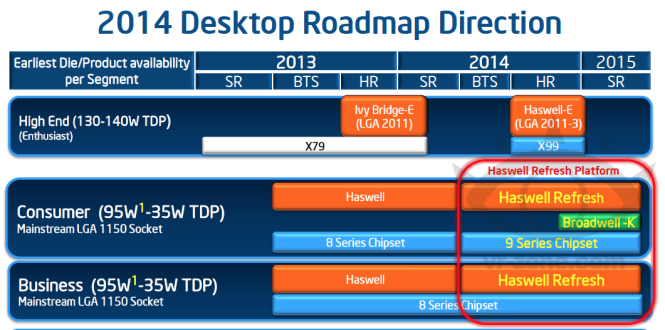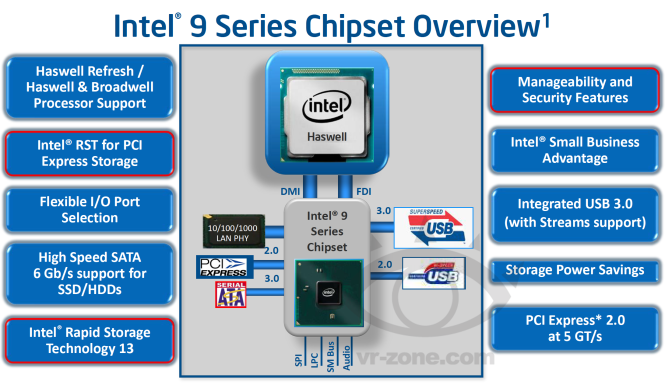Report: Intel Broadwell-K CPU to Launch in Q4 2014
VR-Zone has reported that Intel's 14 nm Broadwell-K CPUs will be launched in Q4 2014.
According to a new desktop roadmap obtained by VR-Zone, Intel's 14 nm Broadwell-K processors will be launched in Q4 2014 and will "take the company through most of 2015." While this itself doesn't come as a particular surprise, the specifics of the posted "2014 Desktop Roadmap Direction" do raise two significant questions about Intel's upcoming "Haswell Refresh" CPUs.
Firstly, the roadmap makes no mention of "non-K" Broadwell CPUs, an omission that may suggest that Intel simply doesn't plan to offer standard versions of the processor. This, however, seems rather unlikely given the company's well-established release practices and CEO Brian Kranzich's announcement in last week's earnings call that production of Broadwell would be delayed from Q3 2013 to Q1 2014 due to the impact of a "defect density issue" on chip yields.
Secondly, the classification of Broadwell-K as a "Mainstream LGA 1150 Socket" CPU differs from previous rumors that suggested a BGA socket and don't shed any light on an earlier report in August. The report suggested that the new CPUs would not be compatible with 8 Series LGA 1150 motherboards due to a change to Intel's power specifications for the socket.
Rounding off VR-Zone's reveal was an "Intel 9 Series Chipset Overview" which drew particular attention to the support for Intel Rapid Storage Technology (RST) 13, RST for PCIe Storage and new "manageability and security features."
Get Tom's Hardware's best news and in-depth reviews, straight to your inbox.
Tarun Iyer was a contributor for Tom's Hardware who wrote news covering a wide range of technology topics, including processors, graphics cards, cooling systems, and computer peripherals. He also covered tech trends such as the development of adaptive all-in-one PCs.
-
natoco So 12 months to wait for a 5% bump in speed.... Oh but the gpu you won't use is twice as powerful. Good times....Reply -
InvalidError So, if there is an LGA1150 Broadwell, it will be coming out roughly a whole year after the mobile/AIO/etc. variants and not be compatible with current motherboards... and the roadmap naming seems to imply LGA1150 models will only be K-models, which means $220+ parts.Reply
This is more or less what I was expecting. -
sykozis Why is a rumor being brought up, that Intel already debunked? Intel stated that mainstream and enthusiast parts would remain on LGA. In fact, Tom's ran an article about it themselves...Reply
I don't see why a "defect density issue" would delay a processor launch by a year....unless, of course, the engineers are just completely clueless on how to fix it. Which would be rather usual for Intel. -
CaedenV Reply11773383 said:So 12 months to wait for a 5% bump in speed.... Oh but the gpu you won't use is twice as powerful. Good times....
nobody upgrades for the CPU anymore, it is all about the chipsets these days. This one is obviously a minor refresh, but adding stream support for USB3, and moving RST to support PCIe Storage (which will be the precursor to SATA Express in the following gen) are worth getting at least a little excited about.
Also, with the TDP going up while overall platform continues to go down means that there is more and more motherboard stuffs being shoved onto the CPU die, but I guess we will have to wait and see what exactly that is.
But you are right. At the end of the day the focus here is to get X86 into more and more mobile devices rather than pushing the high performance devices. With new consoles coming out in a month, and true 'next gen' games starting to pop up on PC next year, I would bet that the late 2015 or early 2016 Skylake/mont refresh will have something special for those of us who upgraded with Sandy Bridge. At that point we are expecting to see full DDR4 support, SATA Express, the possibility of most of the northbridge moving to the CPU die, PCIe4, and possibly the introduction of 10,000 Ethernet for home users.
And on top of that we are expecting a renewed (for at least 1 generation) attention to high end performance rather than the little 5-10% bumps we have seen the last few generations. -
CaedenV Reply11773567 said:Why is a rumor being brought up, that Intel already debunked? Intel stated that mainstream and enthusiast parts would remain on LGA. In fact, Tom's ran an article about it themselves...
I don't see why a "defect density issue" would delay a processor launch by a year....unless, of course, the engineers are just completely clueless on how to fix it. Which would be rather usual for Intel.
Right, ENTHUSIAST parts will remain on LGA. This means that if you are building a system then you are either stuck with a K series part which will run on LGA, or else you will get a motherboard with a BGA chip pre-installed. Presumably these BGA chips will have a pay-to-unlock scheme if you want extra cores, HT, upgraded graphics, etc.
People like myself who typically build higher end systems under a budget will be forced into a more expensive K sku rather than the non-k unit we would normally purchase. Not the end of the world, but it is a bit annoying. Thankfully the next gen will supposedly go back to normal again... but after that I am afraid the nonK chips will be locked to BGA forever. -
jimmysmitty Reply11773383 said:So 12 months to wait for a 5% bump in speed.... Oh but the gpu you won't use is twice as powerful. Good times....
If you want no GPU, then you go with the xX9 chipsets, not theZX8 chipsets. That's been pretty common since LGA1156.
11773473 said:Where's the SATA Express and DDR4 support?
I'm waiting to push my SSD to 2GB/s.
The first platform to have DDR4 is Haswell-EP, might not even make it to the Haswell-E platform but its hard to say.
For us it will probably come in the chips after Broadwell.
I am also excited for SATA Express but honestly, you can't tell the difference for the most part. The main benefit I can see is going to be a increase in IOPS.
11773646 said:11773383 said:So 12 months to wait for a 5% bump in speed.... Oh but the gpu you won't use is twice as powerful. Good times....
nobody upgrades for the CPU anymore, it is all about the chipsets these days. This one is obviously a minor refresh, but adding stream support for USB3, and moving RST to support PCIe Storage (which will be the precursor to SATA Express in the following gen) are worth getting at least a little excited about.
Also, with the TDP going up while overall platform continues to go down means that there is more and more motherboard stuffs being shoved onto the CPU die, but I guess we will have to wait and see what exactly that is.
But you are right. At the end of the day the focus here is to get X86 into more and more mobile devices rather than pushing the high performance devices. With new consoles coming out in a month, and true 'next gen' games starting to pop up on PC next year, I would bet that the late 2015 or early 2016 Skylake/mont refresh will have something special for those of us who upgraded with Sandy Bridge. At that point we are expecting to see full DDR4 support, SATA Express, the possibility of most of the northbridge moving to the CPU die, PCIe4, and possibly the introduction of 10,000 Ethernet for home users.
And on top of that we are expecting a renewed (for at least 1 generation) attention to high end performance rather than the little 5-10% bumps we have seen the last few generations.
10Gbe probably wont come to home users for a few years TBH. Its still pretty expensive and there isn't even a decently priced home router that can use it so having it on your NIC would be pointless as the router will be limited to 1Gbe.
11773671 said:11773567 said:Why is a rumor being brought up, that Intel already debunked? Intel stated that mainstream and enthusiast parts would remain on LGA. In fact, Tom's ran an article about it themselves...
I don't see why a "defect density issue" would delay a processor launch by a year....unless, of course, the engineers are just completely clueless on how to fix it. Which would be rather usual for Intel.
Right, ENTHUSIAST parts will remain on LGA. This means that if you are building a system then you are either stuck with a K series part which will run on LGA, or else you will get a motherboard with a BGA chip pre-installed. Presumably these BGA chips will have a pay-to-unlock scheme if you want extra cores, HT, upgraded graphics, etc.
People like myself who typically build higher end systems under a budget will be forced into a more expensive K sku rather than the non-k unit we would normally purchase. Not the end of the world, but it is a bit annoying. Thankfully the next gen will supposedly go back to normal again... but after that I am afraid the nonK chips will be locked to BGA forever.
Again, Intel has already displaced this. There is nothing pointing towards this as the only thing with extra cores we have seen is a article showing how Intel plans to possibly add extra cores in the CPU as backups because as you get smaller, the chance of failure increases.
This is why rumors are so bad. Rumors spin out of control and keep getting pushed until the actual release.
As for the slides, anyone else notice it says PCIe 2.0 5GT/s? Why would the 9 series chipset (the next in line) go from PCIe 3.0 to PCIe 2.0?
Maybe a misprint or this is just fud. -
InvalidError Reply
Broadwell for mobile/laptop/AIO/etc. only got delayed by a few months from late-2013 to early-2014 due to yield problems. LGA Broadwell-K (presumably K-only models) is the new chip on Intel's roadmap.11773567 said:I don't see why a "defect density issue" would delay a processor launch by a year....unless, of course, the engineers are just completely clueless on how to fix it.
By the time Broadwell-K comes out, Skylake will be just around the corner unless Intel changes their mind about not delaying Skylake. -
InvalidError Reply
Probably no misprint there. With the DMI interface's limited bandwidth, the IO hub does not have sufficient CPU-chipset bandwidth to support PCIe 3.0 on the IO hub on top of all other built-in IO anyway.11773869 said:As for the slides, anyone else notice it says PCIe 2.0 5GT/s? Why would the 9 series chipset (the next in line) go from PCIe 3.0 to PCIe 2.0?
Maybe a misprint or this is just fud.
On Intel systems, the Ivy Bridge or newer i5/i7 CPUs provide 16x PCIe 3.0 lanes (or 40 for SB-E/IB-E on LGA2011) while the IO hub provides PCIe 2.0. Older and lower-end Intel CPUs only support PCIe 2.0.

